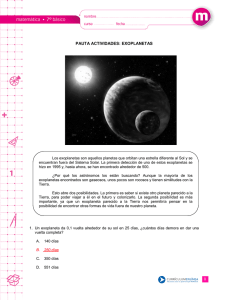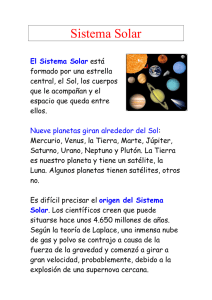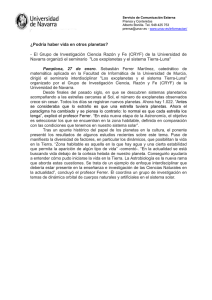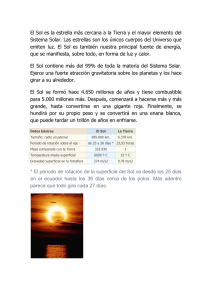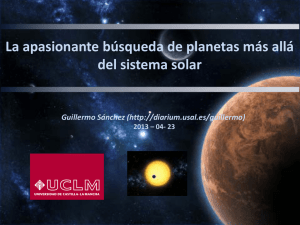Exoplanets Exoplanetas
Anuncio
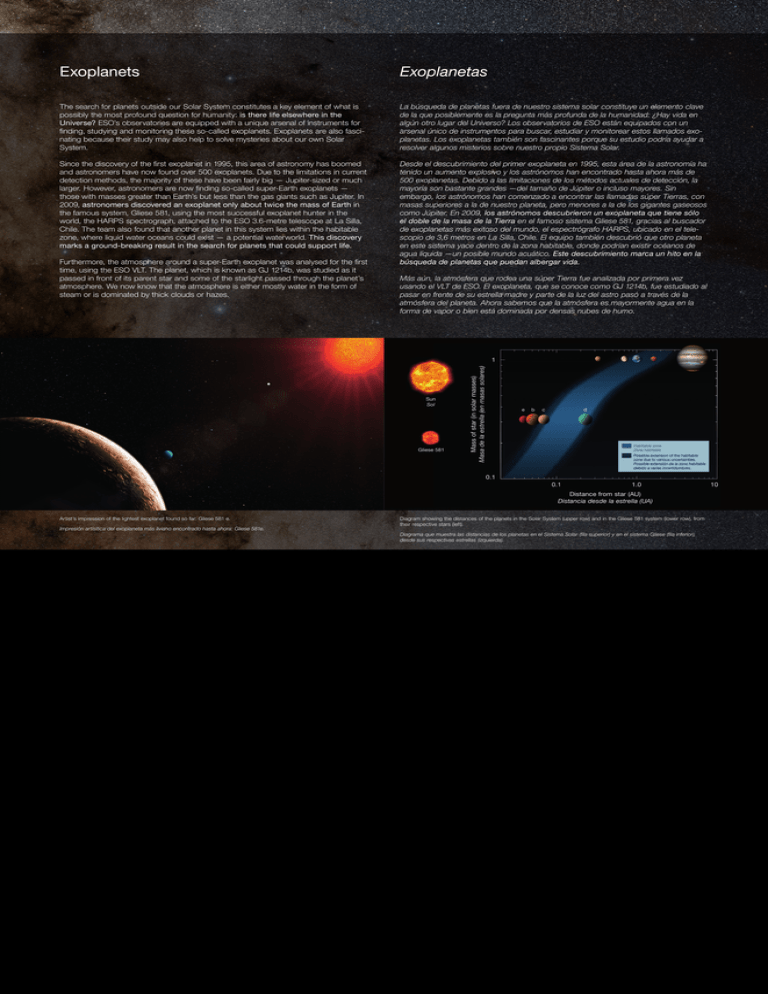
Exoplanets Exoplanetas The search for planets outside our Solar System constitutes a key element of what is possibly the most profound question for humanity: is there life elsewhere in the Universe? ESO’s observatories are equipped with a unique arsenal of instruments for finding, studying and monitoring these so-called exoplanets. Exoplanets are also fascinating because their study may also help to solve mysteries about our own Solar System. La búsqueda de planetas fuera de nuestro sistema solar constituye un elemento clave de la que posiblemente es la pregunta más profunda de la humanidad: ¿Hay vida en algún otro lugar del Universo? Los observatorios de ESO están equipados con un arsenal único de instrumentos para buscar, estudiar y monitorear estos llamados exoplanetas. Los exoplanetas también son fascinantes porque su estudio podría ayudar a resolver algunos misterios sobre nuestro propio Sistema Solar. Since the discovery of the first exoplanet in 1995, this area of astronomy has boomed and astronomers have now found over 500 exoplanets. Due to the limitations in current detection methods, the majority of these have been fairly big — Jupiter-sized or much larger. However, astronomers are now finding so-called super-Earth exoplanets — those with masses greater than Earth’s but less than the gas giants such as Jupiter. In 2009, astronomers discovered an exoplanet only about twice the mass of Earth in the famous system, Gliese 581, using the most successful exoplanet hunter in the world, the HARPS spectrograph, attached to the ESO 3.6-metre telescope at La Silla, Chile. The team also found that another planet in this system lies within the habitable zone, where liquid water oceans could exist — a potential waterworld. This discovery marks a ground-breaking result in the search for planets that could support life. Desde el descubrimiento del primer exoplaneta en 1995, esta área de la astronomía ha tenido un aumento explosivo y los astrónomos han encontrado hasta ahora más de 500 exoplanetas. Debido a las limitaciones de los métodos actuales de detección, la mayoría son bastante grandes —del tamaño de Júpiter o incluso mayores. Sin embargo, los astrónomos han comenzado a encontrar las llamadas súper Tierras, con masas superiores a la de nuestro planeta, pero menores a la de los gigantes gaseosos como Júpiter. En 2009, los astrónomos descubrieron un exoplaneta que tiene sólo el doble de la masa de la Tierra en el famoso sistema Gliese 581, gracias al buscador de exoplanetas más exitoso del mundo, el espectrógrafo HARPS, ubicado en el telescopio de 3,6 metros en La Silla, Chile. El equipo también descubrió que otro planeta en este sistema yace dentro de la zona habitable, donde podrían existir océanos de agua líquida —un posible mundo acuático. Este descubrimiento marca un hito en la búsqueda de planetas que puedan albergar vida. Furthermore, the atmosphere around a super-Earth exoplanet was analysed for the first time, using the ESO VLT. The planet, which is known as GJ 1214b, was studied as it passed in front of its parent star and some of the starlight passed through the planet’s atmosphere. We now know that the atmosphere is either mostly water in the form of steam or is dominated by thick clouds or hazes. Artist’s impression of the lightest exoplanet found so far: Gliese 581 e. Impresión artísitica del exoplaneta más liviano encontrado hasta ahora: Gliese 581e. Más aún, la atmósfera que rodea una súper Tierra fue analizada por primera vez usando el VLT de ESO. El exoplaneta, que se conoce como GJ 1214b, fue estudiado al pasar en frente de su estrella madre y parte de la luz del astro pasó a través de la atmósfera del planeta. Ahora sabemos que la atmósfera es mayormente agua en la forma de vapor o bien está dominada por densas nubes de humo. Diagram showing the distances of the planets in the Solar System (upper row) and in the Gliese 581 system (lower row), from their respective stars (left). Diagrama que muestra las distancias de los planetas en el Sistema Solar (fila superior) y en el sistema Gliese (fila inferior), desde sus respectivas estrellas (izquierda).
